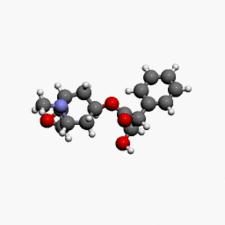Scopolamine (ophthalmic)
Editor-In-Chief: C. Michael Gibson, M.S., M.D. [1]; Associate Editor(s)-in-Chief: Aparna Vuppala, M.B.B.S. [2]
Disclaimer
WikiDoc MAKES NO GUARANTEE OF VALIDITY. WikiDoc is not a professional health care provider, nor is it a suitable replacement for a licensed healthcare provider. WikiDoc is intended to be an educational tool, not a tool for any form of healthcare delivery. The educational content on WikiDoc drug pages is based upon the FDA package insert, National Library of Medicine content and practice guidelines / consensus statements. WikiDoc does not promote the administration of any medication or device that is not consistent with its labeling. Please read our full disclaimer here.
Overview
Scopolamine (ophthalmic) is an anticholinergic agent that is FDA approved for the procedure of diagnosis of mydriasis and cycloplegia. Common adverse reactions include dry mouth, dizziness, somnolence, urinary retention, agitation, visual impairment, confusion, mydriasis and pharyngitis.
Adult Indications and Dosage
FDA-Labeled Indications and Dosage (Adult)
- For mydriasis and cycloplegia in diagnostic procedures. For some pre- and postoperative states when a mydriatic and cycloplegic is needed in treatment of iridocyclitis.
Dosing Information
- For refraction, administer one or two drops in the eye(s) one hour before refracting. For uveitis, administer one or two drops in the eye(s) up to four times daily.
Off-Label Use and Dosage (Adult)
Guideline-Supported Use
There is limited information regarding Off-Label Guideline-Supported Use of Scopolamine (ophthalmic) in adult patients.
Non–Guideline-Supported Use
There is limited information regarding Off-Label Non–Guideline-Supported Use of Scopolamine (ophthalmic) in adult patients.
Pediatric Indications and Dosage
FDA-Labeled Indications and Dosage (Pediatric)
There is limited information regarding FDA-Labeled Use of Scopolamine (ophthalmic) in pediatric patients.
Off-Label Use and Dosage (Pediatric)
Guideline-Supported Use
There is limited information regarding Off-Label Guideline-Supported Use of Scopolamine (ophthalmic) in pediatric patients.
Non–Guideline-Supported Use
There is limited information regarding Off-Label Non–Guideline-Supported Use of Scopolamine (ophthalmic) in pediatric patients.
Contraindications
- Contraindicated in persons with primary glaucoma or a tendency toward glaucoma, e.g., narrow anterior chamber angle; and in those showing hypersensitivity to any component of this preparation.
Warnings
- Do not touch dropper tip to any surface, as this may contaminate the solution.
- FOR TOPICAL OPHTHALMIC USE ONLY - NOT FOR INJECTION.
Precautions
- To avoid excessive absorption, the lacrimal sac should be compressed by digital pressure for two to three minutes after instillation. To avoid inducing angle closure glaucoma, an estimation of the depth of the angle of the anterior chamber should be made.
- Patient Warning
- Patient should be advised not to drive or engage in other hazardous activities when drowsy or while pupils are dilated. Patient may experience sensitivity to light and should protect eyes in bright illumination during dilation. Parents should be warned not to get this preparation in their child’s mouth and to wash their own hands and the child’s hands following administration.
Adverse Reactions
Clinical Trials Experience
- Prolonged use may produce local irritation, characterized by follicular conjunctivitis, vascular congestion, edema, exudate, and an eczematoid dermatitis. Somnolence, dryness of the mouth, or visual hallucinations may occur.
Postmarketing Experience
There is limited information regarding Postmarketing Experience of Scopolamine (ophthalmic) in the drug label.
Drug Interactions
There is limited information regarding Scopolamine (ophthalmic) Drug Interactions in the drug label.
Use in Specific Populations
Pregnancy
Pregnancy Category (FDA): C
There is no FDA guidance on usage of Scopolamine (ophthalmic) in women who are pregnant.
Pregnancy Category (AUS):
There is no Australian Drug Evaluation Committee (ADEC) guidance on usage of Scopolamine (ophthalmic) in women who are pregnant.
Labor and Delivery
There is no FDA guidance on use of Scopolamine (ophthalmic) during labor and delivery.
Nursing Mothers
There is no FDA guidance on the use of Scopolamine (ophthalmic) with respect to nursing mothers.
Pediatric Use
- Safety and effectiveness in pediatric patients have not been established.
Geriatic Use
- No overall differences in safety or effectiveness have been observed between elderly and younger patients.
Gender
There is no FDA guidance on the use of Scopolamine (ophthalmic) with respect to specific gender populations.
Race
There is no FDA guidance on the use of Scopolamine (ophthalmic) with respect to specific racial populations.
Renal Impairment
There is no FDA guidance on the use of Scopolamine (ophthalmic) in patients with renal impairment.
Hepatic Impairment
There is no FDA guidance on the use of Scopolamine (ophthalmic) in patients with hepatic impairment.
Females of Reproductive Potential and Males
There is no FDA guidance on the use of Scopolamine (ophthalmic) in women of reproductive potentials and males.
Immunocompromised Patients
There is no FDA guidance one the use of Scopolamine (ophthalmic) in patients who are immunocompromised.
Administration and Monitoring
Administration
Monitoring
There is limited information regarding Monitoring of Scopolamine (ophthalmic) in the drug label.
IV Compatibility
There is limited information regarding IV Compatibility of Scopolamine (ophthalmic) in the drug label.
Overdosage
There is limited information regarding Chronic Overdose of Scopolamine (ophthalmic) in the drug label.
Pharmacology
Mechanism of Action
- This anticholinergic preparation blocks the responses of the sphincter muscle of the iris and the accommodative muscle of the ciliary body to cholinergic stimulation, producing pupillary dilation (mydriasis) and paralysis of accommodation (cycloplegia).
Structure
- ISOPTO® Hyoscine (scopolamine hydrobromide ophthalmic solution) is an anticholinergic prepared as a sterile topical ophthalmic solution. The active ingredient is represented by the chemical structure:
- Established name: scopolamine hydrobromide
- Chemical name: benzeneacetic acid, α-(hydroxymethyl)-, 9-methyl-3-oxa-9-azatricyclo[3.3.1.02,4]non-7-yl ester, hydrobromide, trihydrate, [7(S)-(1α,2β,4β,5α,7β)]-.
- Each mL contains: Active: scopolamine hydrobromide 0.25%. Preservative: benzalkonium chloride 0.01%. Vehicle: hypromellose 0.5%. Inactives: sodium chloride, glacial acetic acid, sodium acetate (to adjust pH), purified water.
Pharmacodynamics
There is limited information regarding Pharmacodynamics of Scopolamine (ophthalmic) in the drug label.
Pharmacokinetics
There is limited information regarding Pharmacokinetics of Scopolamine (ophthalmic) in the drug label.
Nonclinical Toxicology
There is limited information regarding Nonclinical Toxicology of Scopolamine (ophthalmic) in the drug label.
Clinical Studies
There is limited information regarding Clinical Studies of Scopolamine (ophthalmic) in the drug label.
How Supplied
- In 5 mL plastic DROP-TAINER® dispensers.
- 5 mL NDC 0998-0331-05
- Store at 8°-27°C (46°-80°F). Protect from light.
Storage
There is limited information regarding Scopolamine (ophthalmic) Storage in the drug label.
Images
Drug Images
{{#ask: Page Name::Scopolamine (ophthalmic) |?Pill Name |?Drug Name |?Pill Ingred |?Pill Imprint |?Pill Dosage |?Pill Color |?Pill Shape |?Pill Size (mm) |?Pill Scoring |?NDC |?Drug Author |format=template |template=DrugPageImages |mainlabel=- |sort=Pill Name }}
Package and Label Display Panel
{{#ask: Label Page::Scopolamine (ophthalmic) |?Label Name |format=template |template=DrugLabelImages |mainlabel=- |sort=Label Page }}
Patient Counseling Information
There is limited information regarding Patient Counseling Information of Scopolamine (ophthalmic) in the drug label.
Precautions with Alcohol
- Alcohol-Scopolamine (ophthalmic) interaction has not been established. Talk to your doctor about the effects of taking alcohol with this medication.
Brand Names
- ISOPTO HYOSCINE
Look-Alike Drug Names
There is limited information regarding Scopolamine (ophthalmic) Look-Alike Drug Names in the drug label.
Drug Shortage Status
Price
References
The contents of this FDA label are provided by the National Library of Medicine.
- ↑ Putcha, L.; Cintrón, N. M.; Tsui, J.; Vanderploeg, J. M.; Kramer, W. G. (1989). "Pharmacokinetics and Oral Bioavailability of Scopolamine in Normal Subjects". Pharmacology Research. 6 (6): 481–485. doi:10.1023/A:1015916423156. PMID 2762223.
{{#subobject:
|Label Page=Scopolamine (ophthalmic) |Label Name=Scopolamine (ophthalmic)02.png
}}
{{#subobject:
|Label Page=Scopolamine (ophthalmic) |Label Name=Scopolamine (ophthalmic)03.png
}}


